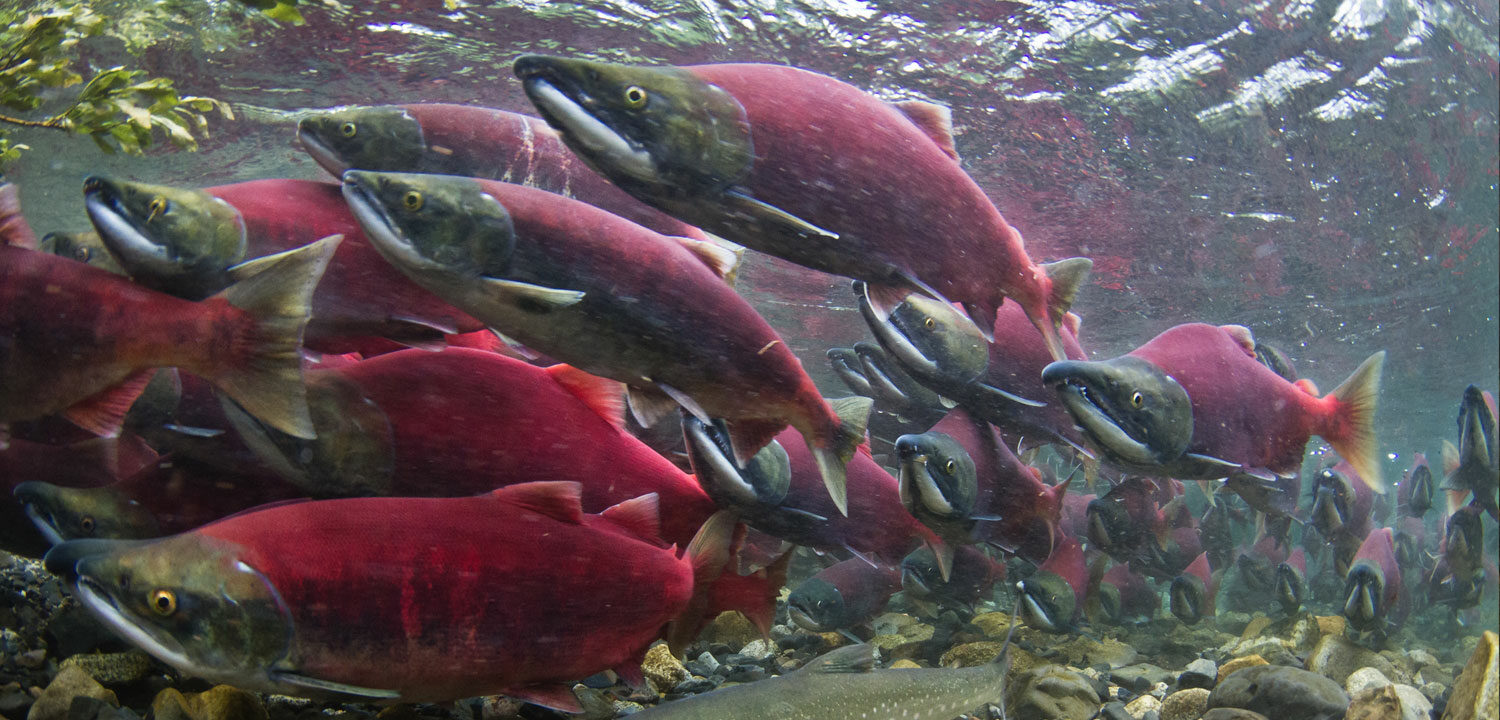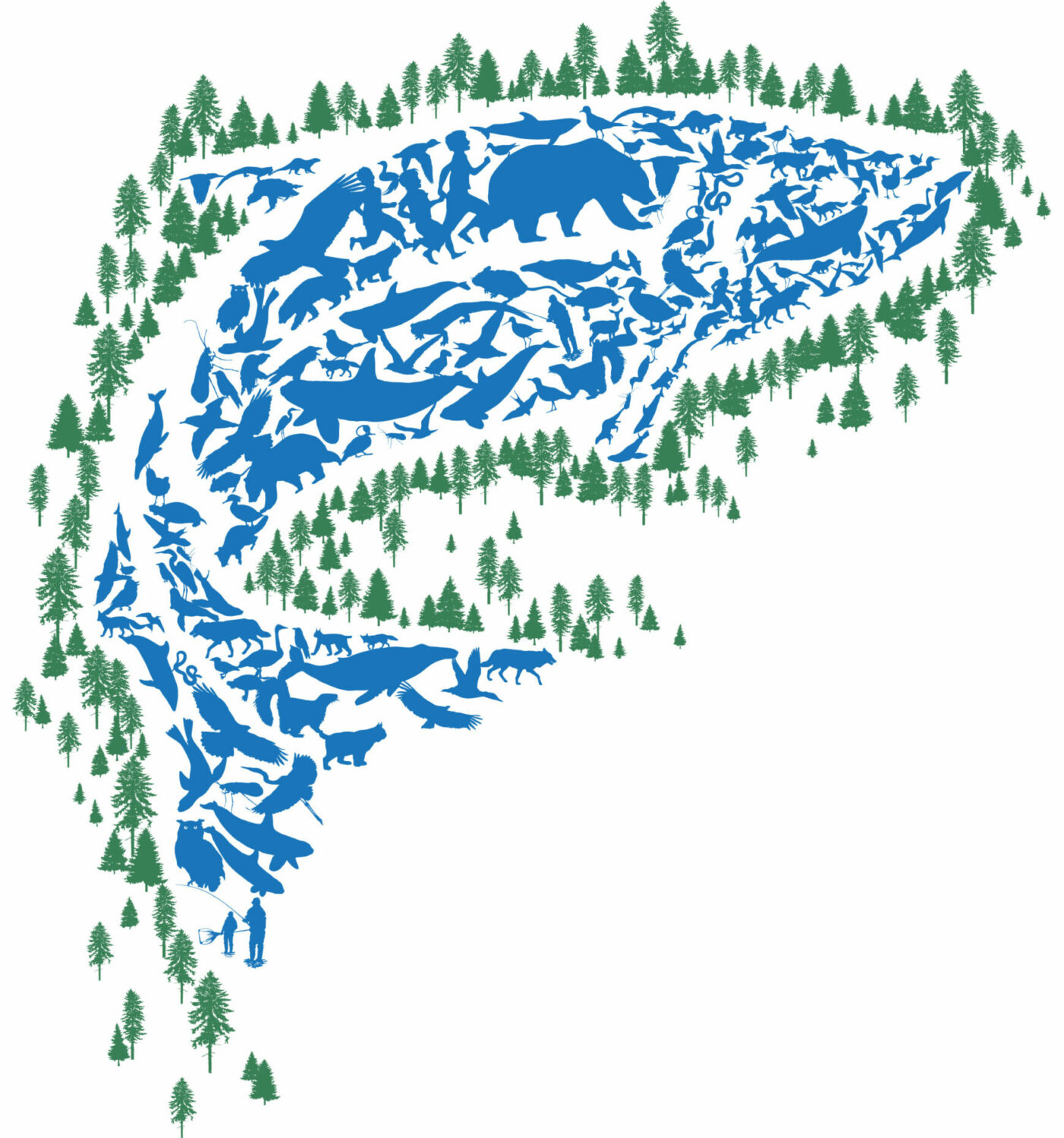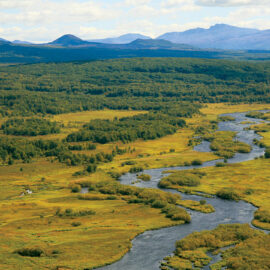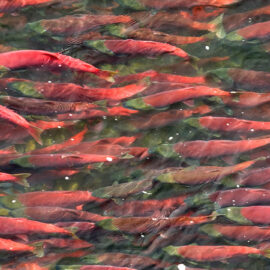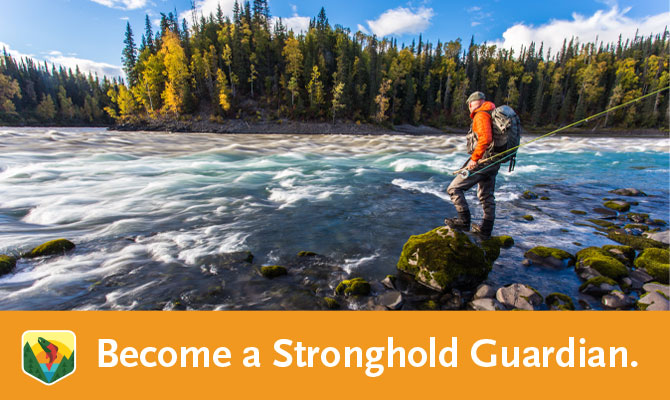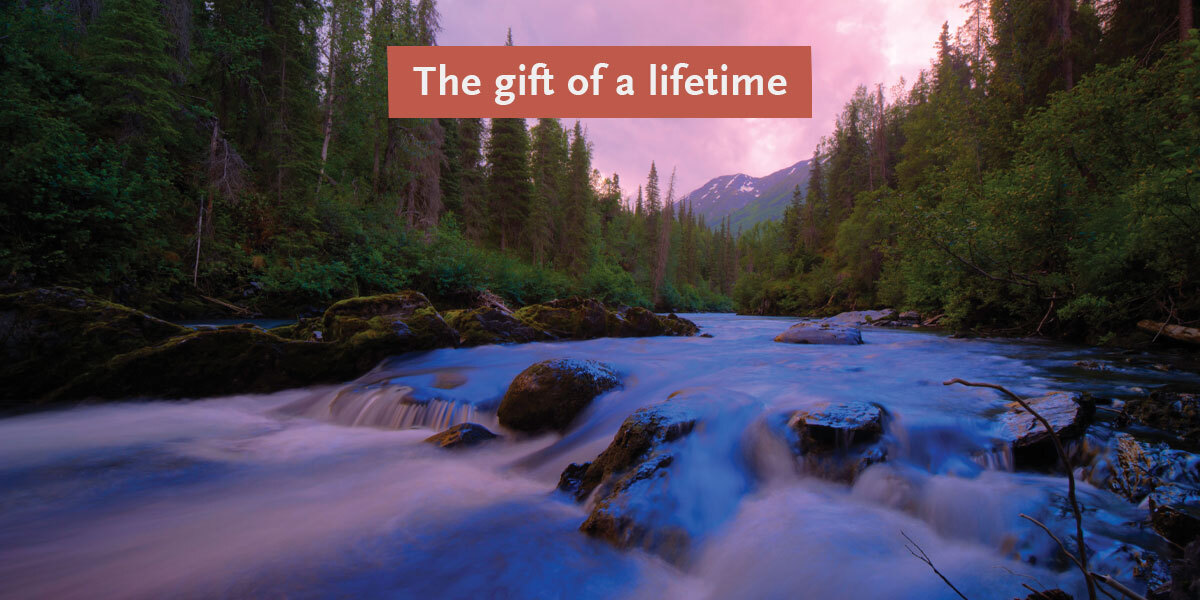By Guido Rahr, Wild Salmon Center President and CEO
Few animals have been as central to the Pacific human experience as salmon. Their annual migrations are a miracle of nature. They feed us and their presence tells us that our rivers are still healthy. From orcas to grizzly bears, at least 137 different species depend on the marine-rich nutrients that wild salmon provide (see our interactive illustration to explore just a few). The last intact salmon watersheds around the North Pacific are composed of free-flowing rivers and dense forests, which provide clean drinking water and absorb carbon to slow climate change. Pacific salmon fuel a $3 billion industry, supporting tens of thousands of jobs and local economies and communities around the Pacific Rim. Millions of people around the Pacific rely on salmon as a healthy and reliable source of protein. Native people have always seen the salmon as the life-sustaining centerpiece of their culture, dating back millennia.
In short, salmon are the key to protecting a way of life rooted in the North Pacific environment: protect salmon and you protect forests, food, water, communities, and economies. But our work over the last two decades has shown that only an aggressive, proactive approach on the strongest remaining salmon rivers—salmon strongholds—can halt the decline of these iconic species and all the benefits we derive from them.
Salmon are the biological foundation of river ecosystems
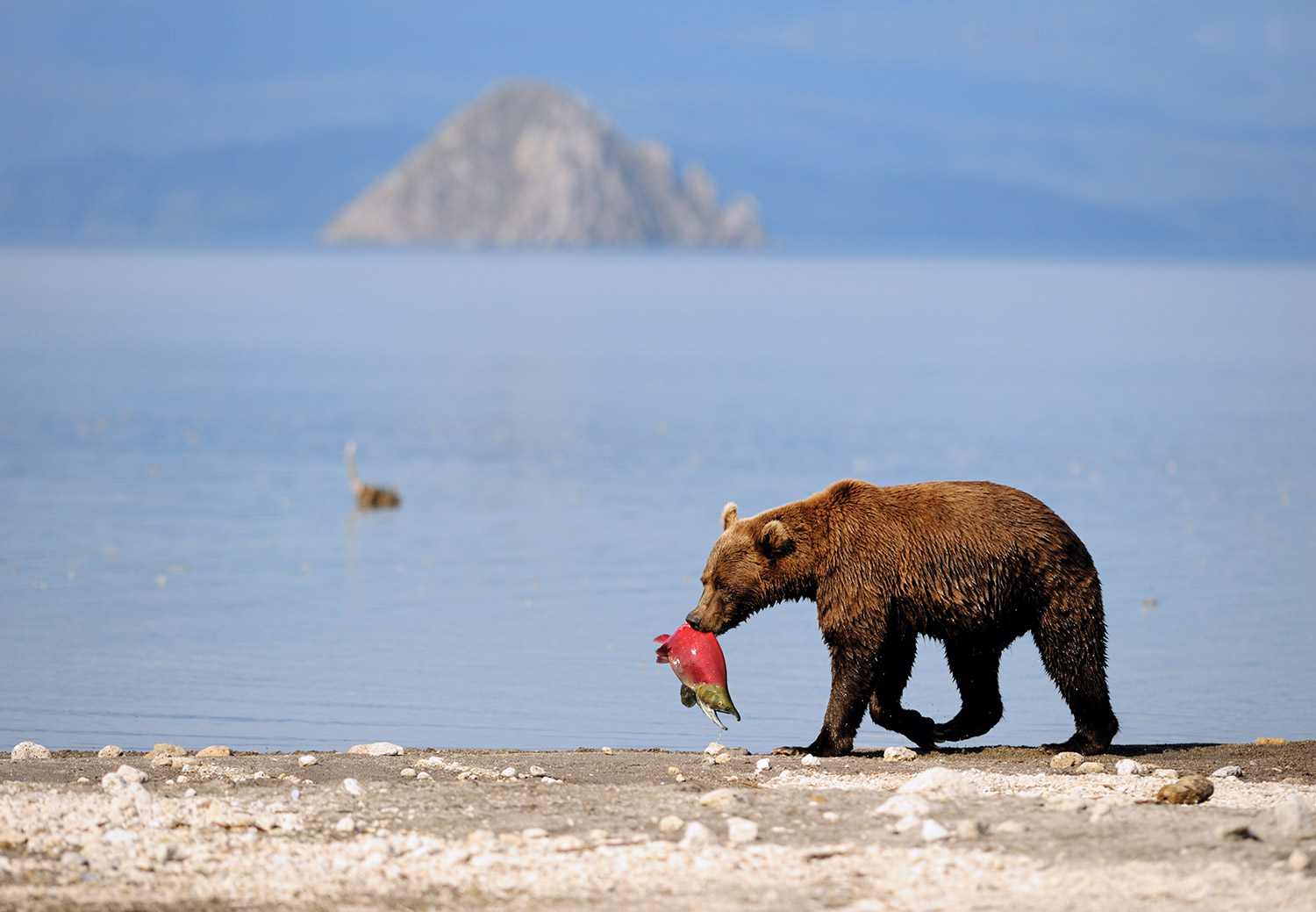
Salmon and freshwater ecosystems are inextricably linked by feedbacks between salmon runs, food webs, and riparian forests. Salmon runs function as enormous pumps that push vast amounts of marine nutrients from the ocean to the headwaters of otherwise low productivity rivers. For example, sockeye salmon runs in southwest Alaska contribute up to 170 tons of phosphorous per year to Lake Iliamna. These nutrients are incorporated into food webs in rivers and surrounding landscapes by a host of over 50 species of mammals, birds, and fish that forage on salmon eggs, juveniles, and adults in freshwater. Predators, such as brown bears, disperse these marine nutrients into surrounding forests, enhancing the growth of stream-side trees that shade and protect stream banks from excessive erosion. In southeastern Alaska, spawning salmon contribute up to 25 percent of the nitrogen in the foliage of trees, resulting in tree growth rates nearly three-times higher than in areas without salmon spawning. As they grow and age, these trees eventually return the favor for salmon by falling into salmon streams and forming log jams that provide shelter for juvenile salmon and protect the gravels that adults use for spawning.
Abundant salmon returns feed the rivers and shape the habitats that support the next generation of wild fish. Generally, the more pristine, diverse, and productive the watershed, the healthier the salmon stocks.
Salmon are the center of economies and cultures
Coastal human communities depend on salmon for both protein and income. In Kamchatka, Russia, 80 percent of the economy is dependent on salmon and other seafood. In Bristol Bay, Alaska, the economic benefit of the world’s largest sockeye salmon run is estimated to exceeded $2.2 billion. Annual sockeye salmon returns here top 60 million fish, create over 15,000 jobs, and bring in $990 million in economic activity in Alaska alone, benefiting commercial, recreational, and subsistence fishermen. But projects like the proposed Pebble Mine threaten all of that.
Columbia River tribes have described the now-inundated fishing hub at Celilo Falls as their former “Wall Street”—a central place of trade and wealth creation. Throughout the West Coast of what is now North America, indigenous communities once sustained some of the highest human populations on the continent because of abundant salmon runs.
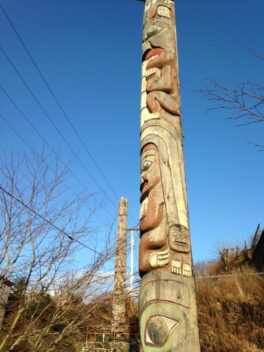
The importance of salmon extends beyond food value. Around the Pacific Rim, salmon have figured centrally in the worldview and daily life of indigenous people. Promised to them in their original creation beliefs, salmon have always held sacred status for Columbia River tribes. Tlingit people of today’s Southeast Alaska characterize salmon as part of a hidden underwater tribe that comes earthward with each run to offer themselves to the Tlingit. When we protect salmon, we honor millennia worth of Indigenous cultures that have evolved alongside the salmon.
Wider society holds a strong belief in the intrinsic beauty of rivers and forests. So many of us have a deep, personal connection to pristine waterways and their iconic residents, especially when one can see the silver, green, and red forms of wild salmon swimming upstream through the clear depths of a river. Most people of the coastal North Pacific Rim have eaten or caught a salmon, and most people think salmon are beautiful and worth saving.
Learn More: Which salmon to eat
Salmon are a symbol to rally around
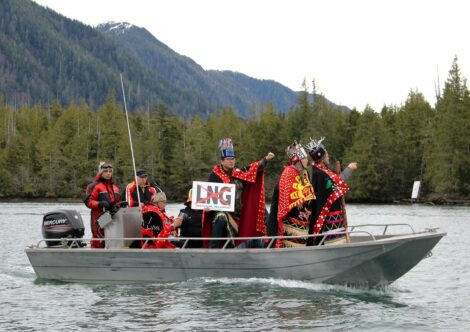
Our collective attraction to salmon is a force to be harnessed in protecting a way of life on the Pacific Rim. By focusing on protecting salmon, with all its associated benefits, we can begin to have a conversation about foregoing certain types of development that are incompatible with watershed health, such as mining, dam building, and forest clear-cutting.
There is broad support among a wide range of social and economic groups in the United States, Canada, Russia, and Japan for healthy wild salmon runs. Polls in Washington and Oregon have consistently shown that the majority of the public is willing to dedicate tens of millions of public dollars every year to save salmon. The species connects us across ideological bounds and political borders in North America. The fish also links us over distant oceans and language barriers, connecting East Asia and the Russia Far East with North America.
Why are salmon declining?
In our rush to modernize and grow, we have overlooked all of the things that salmon need to be healthy. Because of the wide-ranging and complex life histories of salmon, they are vulnerable to impacts from headwater streams to the open ocean. As a result, salmon stocks are dying the “death of a thousand cuts” from steady incursions into their habitat—a road here, a wetland filled there—that cumulatively have pushed many populations to the brink.
Salmon decline is most advanced along the southern portions of their range—in Japan, southeastern Russia, California, Oregon, and Washington. In these southern regions, overharvest is no longer the major factor; habitat loss is dramatic and in many cases may be irreversible. In addition, remaining wild salmon populations are often inundated by domesticated salmon that are bred and reared in hatcheries and are poorly adapted for survival in the wild. Salmon stocks in the northern latitudes of their range—northeastern Russia, British Columbia, and Alaska—generally have healthy habitat, but suffer from legal and illegal overharvest in both the ocean and freshwater spawning rivers.
Why have human efforts to save salmon failed?
Billions of taxpayer dollars have been spent on salmon restoration efforts in the United States and Canada but few success stories have emerged. Some may yet succeed; it is still too early—only a few salmon generations’ worth of time—to discount them. But most salmon restoration efforts have failed so far because they were implemented only after salmon stocks reached low levels of abundance. The Endangered Species Act, for example, only halted coho harvest in Oregon after the salmon were at less than three percent of historic abundance. By the time stocks had been pushed to the threshold of extinction, the factors causing their declines were entrenched. To restore salmon rivers at that point may mean removing mainstem dams, dewatering irrigated crops, eliminating popular salmon hatchery programs, and reclaiming habitat that is now home for thousands of people. That is a huge lift for society, even for a charismatic fish.
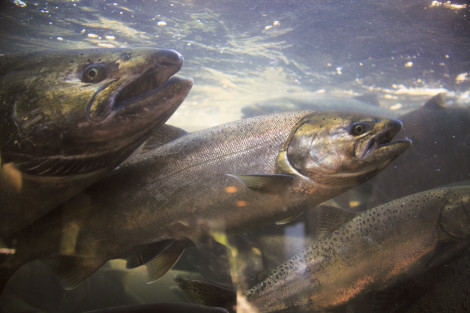
The second mistake we made was damaging and/or replacing the native, locally-adapted genetic stocks with hatchery-bred salmon. The native stocks have adapted to the challenges of each river, and are the building blocks of salmon restoration. We have weakened these native stocks by planting non-native salmon and steelhead stocks for more than 100 years, and allowing them to interbreed with wild fish.
The third mistake is that most of the money dedicated to salmon recovery was and is spent treating symptoms, instead of causes, of salmon decline. For example, fish management budgets are dominated by hatchery programs, which simply replace wild fish with hatchery fish and further weaken the native stocks that hold the promise of long-term recovery. Moreover, much of the resources going towards habitat protections has been spent on temporary fixes, ones that may be helpful in the short term but don’t offer real long-term solutions.
If, instead, the existing forested parts of watersheds were protected, stream processes would create good habitat in perpetuity. Indeed, the protection of water flows and of existing habitat has been neglected by regional efforts. While we spend billions of dollars restoring the most degraded systems, the remaining healthy stocks and watersheds suffer from more logging clearcuts and development projects until these salmon stocks also join the Endangered Species list.
A different strategy: protect salmon strongholds
The most important challenge for long-term salmon conservation is to find and protect the best remaining intact rivers. Once lost, this salmon habitat is politically and economically expensive to reclaim. For this reason, we should focus on the rivers with the best existing habitats and healthy native salmon stocks, and the fewest major human impacts. We call these salmon strongholds.
Moving region by region around the Pacific Rim, we should make permanent investments in the rivers that have the best chance of getting watershed-level habitat protection. With the Pacific Northwest human population doubling roughly every fifty years, we forever cut off our options for a future with salmon if we cannot save a few strongholds of locally adapted salmon stocks.
Clearly, the easiest targets are along the northern parts of the Pacific Rim in northern British Columbia, Alaska, and the Russian Far East. But we can also save key salmon strongholds in California, the Pacific Northwest, Hokkaido and Sakhalin by focusing on smaller, more manageable watersheds, and leveraging legions of salmon lovers to help us protect these places.
Building a legacy for our communities and our children
We are already working to create a system of protected salmon strongholds across the North Pacific. Strongholds are distinguished by their relatively high levels of wild salmon abundance, productivity and diversity, along with habitat quality capable of sustaining wild salmon for decades.
In action, the stronghold strategy has already made significant headway: more than six million acres of protected areas around rivers have been established in the Russian Far East over the last three decades. We have helped secure wild fish emphasis areas along the Oregon Coast and are working on similar policy in Washington and California. We have worked with a broad coalition to protect rivers around Bristol Bay, Alaska from mining claims, saving the world’s largest sockeye run and pushing the area toward permanent conservation status. And we are working with local conservation groups around the North Pacific to strengthen stewardship on the best salmon streams.
Today, the stronghold strategy informs our work across the North Pacific, with impacts that ripple far beyond the rivers that salmon call home.
Make a difference for wild salmon
In the decades since we launched the stronghold strategy, Wild Salmon Center and a network of partners have protected 35.7 million acres of overall habitat and prioritized wild fish biodiversity in 89 rivers across the North Pacific.
Our goal is to permanently safeguard these extraordinary watersheds today—before they’re irreparably damaged.
Support Wild Salmon Center with an online gift.
Go one step further and help Wild Salmon Center achieve a vision of wild salmon rivers for future generations by making a re-occurring gift or consider one of the following options:
- Making a bequest to the Wild Salmon Center in your will;
- Naming WSC as a beneficiary of your life insurance policy or retirement plan;
- Making a gift of stock, land, or other assets;
- Contributing through your Donor Advised Fund (DAF); or
- Making a tax-free rollover gift directly from your IRA.
